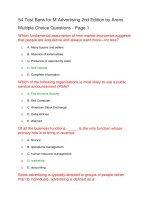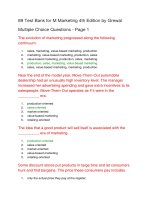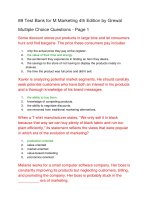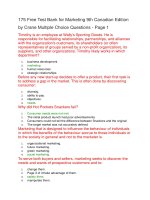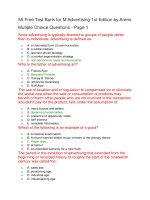Test bank for business 6th canadian edition by ferrell
Bạn đang xem bản rút gọn của tài liệu. Xem và tải ngay bản đầy đủ của tài liệu tại đây (111.25 KB, 21 trang )
Exam
Name___________________________________
TRUE/FALSE. Write 'T' if the statement is true and 'F' if the statement is false.
1)
Products have tangible attributes only.
1)
2)
The goal of business activities is to earn a profit.
2)
3)
Non-profit organizations, such as the Canadian Red Cross, do not have to engage in
management, marketing, or finance activities.
3)
4)
Organizations such as the Special Olympics have two fundamental purposes: to earn a
profit and to accomplish social objectives.
4)
5)
Profit is what it costs to make and sell a product.
5)
6)
Businesses have the right to keep and use their profits as they choose, without
limitations.
6)
7)
Earning profits contributes to society by providing employment, which in turn provides
money that is reinvested in the economy.
7)
8)
Finance is concerned with obtaining money and using it effectively.
8)
9)
Owners have little responsibility to provide funds for the operation of the business.
9)
10) Managers
11) The
coordinate resources to achieve organizational objectives.
focus of all marketing activities is customer satisfaction.
12) Owners
always manage their businesses themselves.
business will help you develop skills to employ in a future career, if that career
takes place in the country where you studied business topics.
10)
11)
12)
13) Studying
13)
14) One
14)
15) A
15)
16) Natural
16)
of the best-known Canadian marketing initiatives of all time is Tim Hortons' "Roll
Up the Rim to Win" campaign.
central issue of economics is how to fulfill consumers' unlimited demand for goods
and services in a world with limited resources.
resources include land, minerals, water, and other gifts of nature which are not
made by humans.
1
Full file at />
17) As
the baby boomers, who make up roughly one-third of Canada's population, retire,
Canada may face a labour shortage in some sectors.
17)
18) Capitalism
18)
19) China
19)
20) Russia,
20)
21) The
21)
is an economic system in which the government owns and operates basic
industries while individuals own most other businesses.
is an example of a communist economy that exists today which satisfies Karl
Marx's ideal of communism.
Poland, Hungary, and other Eastern European nations have turned away from
communism and toward economic systems governed by supply and demand rather than
by central planning.
Chinese state is the largest shareholder among China's largest companies and
influences thousands of other businesses.
22) Most
socialist nations are democratic.
22)
23) Human
resources refer only to the mental abilities of people used to produce goods and
services; it is synonymous with knowledge.
23)
24) If
24)
25) Demand
25)
26) The
26)
free enterprise is going to be successful, individuals must have the right to choose
what career to pursue, where to live, what goods and services to purchase, and more.
is the quantity of goods and services that consumers are willing to buy at
different prices at a specific time.
demand curve is upward sloping.
27) The
equilibrium price is represented by the point where a product's supply and demand
curves intersect.
28) Monopolistic
competition exists when there is only one producer of a product in a given
27)
28)
market.
29) An
oligopoly exists when there are many small businesses selling one standardized
product.
30) Government-granted
monopolies are not subject to government-regulated prices.
31) A
product's equilibrium price is constantly changing in response to changes in economic
conditions, availability of resources, and degree of competition.
2
Full file at />
29)
30)
31)
32) Economic
expansion occurs when an economy is growing and people are spending more
32)
money.
33) The
standard of living rises because people have less money to spend.
34) Inflation
35) A
is a condition characterized by falling prices.
severe recession may turn into a depression.
36) During
a recession, unemployment is unusually low.
domestic product is the sum of all goods and services produced in a country
during a year.
33)
34)
35)
36)
37) Gross
37)
38) Since
38)
1997, it has been common policy for the government of Canada to run large
budget deficits.
39) Canada
40) When
has had a positive trade balance for much of the last decade.
a nation collects more from taxes than it spends, it has a budget deficit.
41) Industrialization
42) The
39)
40)
mostly occurred in Central Canada.
41)
Canadian Pacific Railway linked Canada from north to south.
42)
43) Advertising
first made consumers aware of differences in products and prices in the
marketing economy.
43)
44) Entrepreneurs
44)
risk their wealth, time, and effort to develop for profit an innovative
product or way of doing something.
45) Entrepreneurship
46) In
is essential to a free-enterprise system.
a free-market system, the government regulates business.
47) Free-market
capitalism and laissez-faire capitalism are essentially the same thing.
has shown that ethical behaviour cannot only enhance a company's reputation
but can also drive profits.
45)
46)
47)
48) Research
48)
49) Society
49)
demands ethical and socially responsible business behaviour towards customers
and investors only. There seems to be less of a concern for other stakeholder groups
including government regulators and the environment.
3
Full file at />
MULTIPLE CHOICE. Choose the one alternative that best completes the statement or answers the question.
50) Businesses
differ from non-profit organizations in that a business' focus is on:
50)
A) profits.
B) plans.
price.
D) goods.
E) organization.
C)
51) When
purchasing a product, the consumer is actually buying its anticipated benefits and
the ________ it brings.
A) form
B) costs
C) price
D) satisfaction
E) productivity
51)
52) If
52)
a business is to be successful in the long run, it must treat its customers, employees,
and community with social:
A) responsibility
B) insight
C) interests
D) integrity
E) agendas
of the following is not a product?
A) Profits earned by businesses
B) A veterinarian's treatment of a pet's injuries
C) A checkup by a doctor
D) A lawyer's advice in a divorce case
E) A Mac personal computer
53) Which
53)
54) The
54)
goal of business is to earn:
A) resources.
B) independence.
C) a profit.
D) responsibility.
E) respect.
4
Full file at />
55) The
functions of organizing, staffing, planning, and controlling are most closely
associated with:
A) employees
B) accountants
C) stockholders
D) customers
E) managers
55)
56) Which
56)
57) Advertising,
57)
58) One
58)
59) When
59)
60) The
60)
of the following functions involve activities designed to provide goods and
services that fulfill the needs and wants of consumers?
A) Marketing
B) Accounting
C) Finance
D) Production
E) Engineering
personal selling, coupons, and sweepstakes are forms of:
A) marketing research
B) management activities
C) publicity
D) the marketing mix
E) promotion
of the best-known Canadian marketing initiatives of all time is:
A) The Air Miles Program
B) HBC's reward program
C) Petro-Points
D) Tim Hortons' "Roll Up the Rim to Win"
E) The President's Choice points
a business fails or does not make a profit, the ________ have the most to lose.
A) workers
B) customers
C) consumers
D) managers
E) owners
function concerned with obtaining and managing money and using it effectively is
called:
A) personnel.
B) marketing.
C) finance.
D) management.
E) production and operations.
5
Full file at />
61) The
group of people to whom management activities most apply is:
A) bankers.
B) consumers.
C) government regulators.
D) owners.
E) employees.
61)
62) All
of the following are factors of production used to make goods and services, except:
resources.
B) natural resources.
C) customers.
D) human resources.
E) capital.
62)
63) All
of the following are examples of natural resources, except:
A) nickel.
B) fisheries.
C) forests.
D) human mental talent.
E) minerals.
63)
64) Factors
64)
65) Resources
65)
66) Which
66)
A) financial
of production are:
A) free.
B) resources used to produce goods and services.
C) fixed resources.
D) seldom in demand.
E) taxes.
may be:
A) human.
B) services.
C) concepts.
D) machines.
E) ideas.
of the following questions are addressed by all economic systems?
A) Who will produce the goods?
B) What goods and services should be produced?
C) How much of each good and service should be produced?
D) How should the goods and services be distributed?
E) All of these questions must be addressed by all economic systems.
6
Full file at />
67) All
of the following are true in a communist economy, except:
A) that consumers have a wide choice of goods and services.
B) that supply is determined by central government planning.
C) the means of production are owned by the government.
D) the government decides how the goods will be produced.
E) the government chooses what will be produced.
67)
68) Communist
68)
societies:
not spend much on defense.
B) have only one class of people.
C) seldom have consumer shortages.
D) have a high standard of living.
E) appear to be efficient and equitable, at least in theory.
A) do
69) Socialism:
69)
A) allows
only private ownership of business.
only government ownership of the factors of production.
C) is becoming more popular.
D) has government ownership of basic industries.
E) all of the answers accurately describe socialism.
B) allows
70) Socialist
economies praise their egalitarianism, which means income and social services
are distributed:
A) equally.
B) to the elite only.
C) to the homeless.
D) unequally.
E) to the poor only.
70)
71) Under
71)
72) The
72)
a capitalist system, goods and services provided are determined by all of the
following, except:
A) businesses owned by the government.
B) competition.
C) consumer demand.
D) supply.
E) market forces.
difference between pure capitalism and modified capitalism is that:
A) under modified capitalism, there is less government regulation.
B) for either form of capitalism, government regulation is equal.
C) under pure capitalism, there is less government regulation.
D) under pure capitalism, there is more government regulation.
E) none of the answers accurately describe the difference between pure capitalism and
modified capitalism.
7
Full file at />
73) Most
economic systems:
A) are ineffective.
B) give individuals freedom.
C) exist in a pure form.
D) create revolutions.
E) exist in a mixed form.
73)
74) Private
74)
75) Which
of the following systems has the highest degree of competition?
capitalism
B) Communism
C) Pure capitalism
D) Mixed economy
E) Socialism
75)
which economic system(s) are basic services provided by the central government?
A) Communism and capitalism
B) Communism and socialism
C) Socialism only
D) Capitalism and socialism
E) Capitalism only
76)
property, profits, independent business decisions, and freedom of choice are
rights associated with:
A) socialism.
B) egalitarianism.
C) free enterprise.
D) communism.
E) humanitarianism.
A) Modified
76) In
77) Which
of the following countries best depict a communist economic system?
B) Poland
C) Russia
D) Canada
E) Cuba
77)
A) Hungary
78) If
an economist is analyzing the quantity of goods or services that businesses are willing
to sell at different prices at specific times, then the focus is on:
A) equilibrium.
B) supply.
C) demand.
D) competition.
E) pure competition.
8
Full file at />
78)
79) Suppliers
are generally willing to:
A) supply more at a lower price.
B) determine equilibrium prices.
C) supply more at a higher price.
D) lower prices below costs.
E) demand more at a higher price.
79)
80) When
80)
Walmart has a sale on digital cameras:
will demand more digital cameras.
B) the store won't supply more digital cameras than it normally does.
C) the manufacturer will halt production of digital cameras.
D) consumers won't demand more digital cameras than normal.
E) consumers will demand fewer digital cameras.
A) consumers
81) When
Apple introduced the iPod portable digital music player, the price of and demand
for digital music players was high. As a result:
A) consumers stopped buying digital music players.
B) other suppliers introduced digital music players to meet the demand.
C) competition was not allowed to enter the market.
D) manufacturers stopped producing digital music players.
E) the equilibrium price met the supply.
81)
82) Supply
82)
83) Competition
83)
and demand may be an efficient way to distribute resources:
A) and it is always fair.
B) but it doesn't allow the poor to get rich.
C) but it helps inefficient producers to succeed.
D) although equilibrium price is determined by the government.
E) but it may not distribute resources equally among those who need them.
fosters efficiency because:
government regulates prices.
B) producers have to offer the best products at reasonable prices.
C) businesses can set whatever prices they want.
D) supply depresses prices.
E) all buyers have perfect knowledge.
A) the
84) If
Chrysler raises the prices of its new models of pickup trucks by 4 percent and General
Motors and Ford follow by raising prices by a similar amount, then this is evidence of:
A) a monopoly.
B) an oligopoly.
C) monopolistic competition.
D) supply and demand.
E) pure competition.
9
Full file at />
84)
85) Monopolies
that function in a capitalistic economy are likely to have prices determined
85)
by:
A) the
interaction of supply and demand.
law of supply.
C) the law of demand.
D) equilibrium interaction.
E) government regulation.
B) the
86) Using
the supply and demand curves shown in the graph that follows, what is the
equilibrium price for soft drinks?
86)
[INSERT GRAPHIC]
A) 75
cents
B) 50
cents
C)
55 cents
D) 35
cents
E) 45
cents
87) When
businesses can promote different features of their products and consumers are
willing to pay more for products containing the features they desire, the competitive
environment is probably:
A) pure capitalism.
B) pure competition.
C) a monopoly.
D) an oligopoly.
E) monopolistic competition.
87)
88) Agricultural
88)
commodities are usually sold in which competitive environment?
competition
B) Oligopoly
C) Pure competition
D) Monopoly
E) Pure capitalism
A) Monopolistic
89) Which
competitive environment best describes the market for wheat, corn, and cotton?
A) Pure competition
B) Monopolistic competition
C) Oligopoly
D) Pure capitalism
E) Monopoly
89)
90) Which
90)
competitive environment best describes the market for Canadian air travel?
competition
B) Monopoly
C) Pure competition
D) Pure capitalism
E) Oligopoly
A) Monopolistic
10
Full file at />
91) Economic
expansion occurs when:
A) prices begin to rise and incomes begin to fall.
B) fewer goods and services are produced than consumers demand.
C) a nation's standard of living drops quickly.
D) an economy is growing and people are spending more money.
E) employment levels decline over time.
91)
92) Economic
contraction occurs when:
levels increase over time.
B) prices begin to rise and incomes rise accordingly.
C) a nation's standard of living remains stable over time.
D) spending declines and businesses cut back on production.
E) more goods and services are demanded by consumers.
92)
continuing rise in prices over a period of time refers to:
A) stagflation.
B) an economic contraction.
C) a recession.
D) an economic expansion.
E) inflation.
93)
A) employment
93) A
94) Economic
contraction generally leads to:
A) higher employment.
B) deflation.
C) increased spending.
D) inflation.
E) recession.
94)
95) Countries
95)
96) Increased
96)
measure the state of their economies in order to:
A) avoid taking corrective action.
B) control government spending.
C) let other nations know the state of their economic health.
D) regulate wages and employment.
E) determine whether they are expanding or contracting.
unemployment can reduce consumer demand for goods and services leading to
A) higher employment levels.
B) economic expansion.
C) deflation.
D) inflation.
E) a budget deficit.
11
Full file at />
97) A
budget surplus, when a nation spends less than it takes in from taxes, is the opposite of
a(n):
A) balance of trade.
B) economic expansion.
C) economic contraction.
D) stagnant income.
E) budget deficit.
most recent recession in Canada occurred during:
A) 20132015
B) 20082009
C) 20102011
D) 20012003
E) 19901992
97)
98) The
98)
99) Inflation
99)
in Canada is typically measured by:
consumer price index.
B) The trade balance.
C) The gross domestic product.
D) Worker productivity.
E) Per capita income.
A) The
100)
The concept of GDP in relation to population is called:
A) Average income
B) Per capita income
C) GDP per capita
D) Income per head
E) Gross national product
100)
101)
GDP per capita is highest in which of the following countries?
A) Argentina
B) Australia
C) Canada
D) Germany
E) the United States
101)
102)
The early economy of Canada was marked by settlers who operated a society primarily
based on:
A) agriculture.
B) information.
C) manufacturing.
D) technology.
E) sweatshops.
102)
12
Full file at />
103)
All of the following are associated with the Industrial Revolution, except:
A) farm equipment.
B) machines.
C) computers.
D) railroads.
E) factories.
103)
104)
In the history of the Canadian economy, the period or stage following the Industrial
Revolution was known for its emphasis on:
A) manufacturing.
B) agriculture.
C) technology.
D) service.
E) both manufacturing and agriculture.
104)
105)
The entrepreneur has been primarily associated with a willingness to
A) stay conventional.
B) be repetitive.
C) take risks.
D) follow others.
E) be conservative.
105)
106)
Time-pressed Canadians are increasingly:
A) relaxing
B) sleeping
C) reading
D) reducing the time they spend at work
E) paying others to do their own home tasks
106)
107)
As women entered the workforce in increasing numbers, Canadians began to pay others
to do jobs for them which made their lives easier. This began the transformation of the
Canadian economy into a:
A) agricultural economy
B) financial economy
C) service economy
D) sluggish economy
E) industrial economy
107)
13
Full file at />
108)
Technological trends have gradually changed Canada to a(n) ________ economy
focused on making life easier for busy consumers.
A) manufacturing
B) marketing
C) agriculture
D) technology
E) service
108)
109)
All of the following are associated with the manufacturing economy, except:
A) marketing.
B) marketing research.
C) cable television.
D) buying on a time-payment plan.
E) advertising.
109)
110)
What do Enron, Maple Leaf, and SNC-Lavalin have in common?
A) They were scrutinized by the media because of their use of sweatshops in less
developed nations.
B) They are all corporations that experienced a sudden, unexplained increase in their
stock price.
C) They all experienced a number of ethical issues widely publicized in the media.
D) They are the top three Canadian manufacturing organizations.
E) They are all service producing multi-national corporations.
110)
ESSAY. Write your answer in the space provided or on a separate sheet of paper.
111)
Briefly describe the goals of a business, especially the primary goal.
112)
Provide an example of a product which is also a service and how that provides value to customers.
113)
Provide an example of an organization that does not have the fundamental purpose of earning
profits.
114)
Describe one business' efforts to reduce the impact that business' waste has on the environment.
115)
Describe the relationship between management, marketing, finance, owners, employees, and
customers.
116)
Describe some of the activities of marketing professionals.
117)
What are the three questions that all economic systems must answer? Who answers them under a
communist system? A socialist system? A capitalist system?
118)
List the three major categories of economic resources and give one example of each.
14
Full file at />
119)
Contrast communism and socialism, in terms of business ownership, competition, profits, product
availability and price, and employment options.
120)
Define supply, demand, and equilibrium price, and explain their relationship with each other.
121)
Summarize the four types of competitive environments: pure competition, monopolistic
competition, oligopoly, and monopoly.
122)
Discuss the issues involved in measuring a country's economy.
123)
Contrast an economic contraction with an economic expansion, in terms of spending, production
levels, employment levels, and price levels.
124)
Why are entrepreneurs important to the economy?
125)
Trace the evolution of the Canadian economy.
15
Full file at />
Answer Key
Testname: UNTITLED1
1) FALSE
2) TRUE
3) FALSE
4) FALSE
5) FALSE
6) FALSE
7) TRUE
8) TRUE
9) FALSE
10) TRUE
11) TRUE
12) FALSE
13) FALSE
14) TRUE
15) TRUE
16) TRUE
17) TRUE
18) FALSE
19) FALSE
20) TRUE
21) TRUE
22) TRUE
23) FALSE
24) TRUE
25) TRUE
26) FALSE
27) TRUE
28) FALSE
29) FALSE
30) FALSE
31) TRUE
32) TRUE
33) FALSE
34) FALSE
35) TRUE
36) FALSE
37) TRUE
38) FALSE
39) TRUE
40) FALSE
41) TRUE
42) FALSE
43) TRUE
44) TRUE
45) TRUE
46) FALSE
47) TRUE
48) TRUE
49) FALSE
50) A
16
Full file at />
Answer Key
Testname: UNTITLED1
51) D
52) A
53) A
54) C
55) E
56) A
57) E
58) D
59) E
60) C
61) E
62) C
63) D
64) B
65) A
66) E
67) A
68) E
69) D
70) A
71) A
72) C
73) E
74) C
75) C
76) B
77) E
78) B
79) C
80) A
81) B
82) E
83) B
84) B
85) E
86) C
87) E
88) C
89) A
90) E
91) D
92) D
93) E
94) E
95) E
96) C
97) E
98) B
99) A
100) C
17
Full file at />
Answer Key
Testname: UNTITLED1
101)
102)
103)
104)
105)
106)
107)
108)
109)
110)
111)
B
A
C
E
C
E
C
E
C
C
Answers will vary
The primary goal of businesses is to earn a profit, the difference between what it costs to make and sell a
product and what a customer pays for it. Other business goals may include acting ethically and socially
responsible.
112) Answers will vary
Dry cleaning, a check-up by a doctor, a performance by a hockey player–these are examples of services.
113) Answers will vary
Non-profits such as the Canadian Red Cross, Special Olympics, and other charities and social causes.
114) Answers will vary
Best Buy offers recycling of electronics at all of its stores. The stores take cellphones, wide-screen TVs, an
most other electronic products in their green program, regardless of where they were purchased.
115) Answers will vary
Management involves coordinating the efforts of employees to achieve organizational objectives. Marketin
involves activities designed to provide goods and services that satisfy customers. Finance involves
activities concerned with obtaining money–from owners and investors and other sources–and using it
effectively.
116) Answers will vary
Marketers gather information and conduct research to determine what customers want. Using information
gathered from marketing research, marketers plan and develop products and make decisions about how
much to charge for their products and when and where to make them available.
18
Full file at />
Answer Key
Testname: UNTITLED1
117)
Answers will vary
The three economic questions are (1) What goods and services, and how much of each, will satisfy the
needs of the consumer? (2) How will goods and services be produced, who will produce them, and with
what resources will they be produced? (3) How are the goods and services to be distributed to the
consumer? Under a true communist system, these questions are answered by a central government
planning committee. Under a true socialist system, central planning answers the questions for basic goods
and industries, while the forces of supply and demand answer them for most of the other products. Within
a capitalist system, competition, supply, and demand determine the answers.
118) Answers will vary
Natural resources include vast supplies of fresh water, large areas of forest, nickel, copper, uranium, and
large deposits of oil and natural gas.
Human resources include labour, referring to the physical and mental abilities that people use to produce
goods and services.
Financial resources include the funds used to acquire the natural and human resources needed to provide
products.
119) Answers will vary
See Table 1.1 - Comparisons of Communism, Socialism, and Capitalism.
120) Answers will vary
Supply is the quantity of goods or services that businesses are willing to sell at different prices at a specific
time. Demand is the quantity of goods or services that consumers are willing to buy at different prices at a
specific time. Both can be shown graphically with supply and demand curves. Where the supply and
demand curves intersect is the equilibrium price, the price at which the quantity of products businesses are
willing to supply equals the quantity of products consumers are willing to buy at a specific point in time.
If economic conditions, resource availability, degree of competition, or some other factor changes either
supply or demand, a new equilibrium price will be established.
19
Full file at />
Answer Key
Testname: UNTITLED1
121)
Answers will vary
Pure competition exists when there are many small businesses selling one standardized product, such as
agricultural commodities like wheat, corn, and cotton.
Monopolistic competition exists when there are fewer businesses than in a pure-competition environment
and the differences among the goods they sell are small.
An oligopoly exists when there are very few businesses selling a product. In an oligopoly, individual
businesses have control over their products' price because each business supplies a large portion of the
products sold in the marketplace.
A monopoly exists when there is one business providing a product in a given market. Utility companies tha
supply electricity, natural gas, and water are monopolies. The government permits such monopolies
because the cost of creating the good or supplying the service is so great that new producers cannot
compete for sales.
122) Answers will vary
Countries measure the state of their economies to determine whether they are expanding or contracting and
whether corrective action is necessary to minimize the fluctuations. One commonly used measure is gross
domestic product (GDP), the sum of all goods and services produced in a country during a year. Another
important indicator of a nation's economic health is the relationship between its spending and income
(from taxes).
123) Answers will vary
Economic contraction occurs when spending declines. Businesses cut back on production and lay off
workers, and the economy as a whole slows down. Contractions of the economy lead to recession
characterized by rising levels of unemployment. Rising unemployment levels tend to stifle demand for
goods and services, which can have the effect of forcing prices downward.
Economic expansion occurs when an economy is growing and people are spending more money. Their
purchases stimulate the production of goods and services, which in turn stimulates employment. The
standard of living rises because more people are employed and have money to spend. Rapid expansions of
the economy, however, may result in inflation, a continuing rise in prices.
124) Answers will vary
Entrepreneurs are important to the economy because they are willing to take the risks necessary to bring
ideas for new goods, services, and business practices into the marketplace. They bring together all the
factors of production to produce new products.
20
Full file at />
Answer Key
Testname: UNTITLED1
125)
Answers will vary
The Early Economy - Before the colonization of North America, Native Americans lived as hunter/gatherer
and farmers, with some trade among tribes. The first major business competitors in Canada were the North
West Trading Company and the Hudson Bay Company.
The Industrial Revolution - The nineteenth century and the Industrial Revolution brought the development
of new technology and factories. The factory brought together all the resources needed to make a product
–materials, machines, and workers.
The Manufacturing and Marketing Economies - Industrialization brought increased prosperity, and many
Canadians found jobs in the manufacturing economy–one devoted to manufacturing goods and providing
services rather than producing agricultural products.
The Service and New Digital Economy - After World War II, with the increased standard of living,
Canadians had more money and more time. They began to pay others to perform services that made their
lives easier. Beginning in the 1960s, more and more women entered the workforce.
21
Full file at />
